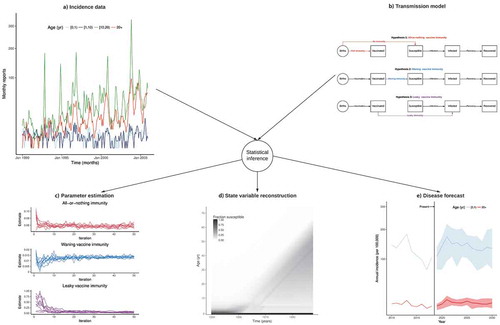Figures & data
Figure 1. Confronting transmission models with incidence data to elucidate the epidemiology of pertussis.
(a) Age-specific monthly case reports of pertussis in Massachusetts during 1990–2005 (data from Ref. Citation7). (b) Schematic of three mathematical transmission models with three different assumptions on the nature of vaccine-derived immunity (all-or-nothing, waning, or leakyCitation7-Citation9). (c) Convergence plot of vaccine parameters (as defined in panel B) to their maximum likelihood estimates. (d) Model-based hindcasts of the fraction of individuals susceptible to pertussis infection, according to time (x-axis) and to age (y-axis). (e) Model-based forecasts of pertussis annual incidence in infants [0,1) yr and adults 20 yr. The figure illustrates how, via statistical inference methods,Citation10-Citation12 pertussis incidence data (panel A) can be confronted with transmission models to test different scientific hypotheses about the nature of vaccine immunity (panel B). Each fitted model leads to different parameter estimates and receives a different degree of support from the data (panel C). The best-fitting model (here the model with waning vaccine immunity) can then be used to infer quantities that are not directly observable (like the degree of susceptibility in the population, panel D) and to forecast the burden of disease (panel E). Panel D illustrates the end-of-honeymoon effect.Citation7 In the prevaccine era, cases are concentrated in young children who, upon recovery, develop long- lived immunity against reinfection, resulting in strong herd immunity in older individuals. The inception of mass vaccination leads to an overall reduction in transmission in those vaccinated and in the population at large. Hence, children who were not vaccinated (or in whom vaccinal protection did not initially take) are increasingly likely to reach adulthood having avoided natural infection. Concomitantly, older cohorts, with their long-lived immunity derived from natural infection during the prevaccine era, gradually die out. The result is the gradual buildup of susceptibles, which leads to a gradual resurgence.

